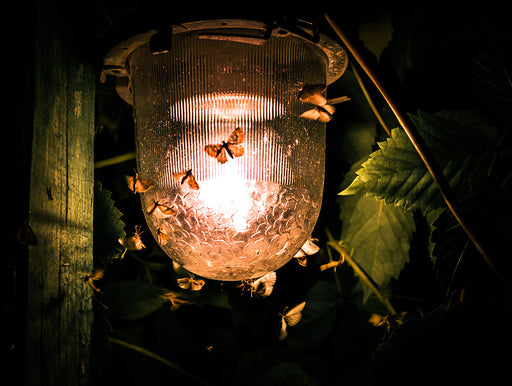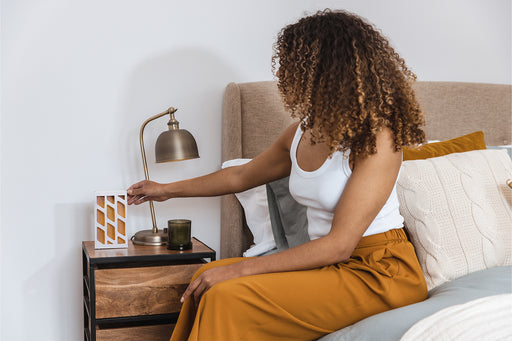Where Do Moths Sleep?

When do moths sleep, how long do moths sleep, and most importantly, where are they when they take these naps? In this guide, we'll cover it all!
Sleep is a fundamental part of life. After all, everyone has to sleep, right? Still, it can be hard to figure out much about the sleeping habits of insects. With little discussion on the topic, it all seems quite mysterious.
So how do moths sleep and what are their sleeping habits? Do they take naps during the day? For that matter, how much do moths have to sleep? Below, we will go over everything you need to know so you will never have to wonder again. Plus, you can apply this information to your pest control strategy!
Do moths sleep?
First, let's answer the pressing question: do moths sleep? For all intents and purposes, yes, moths sleep. Their sleep is more of a rest-like regeneration period. For most species of moths, this sleep-like state occurs during the daytime. This is because moths are nocturnal.
Moths do not have eyelids. As such, you can't tell if a moth is sleeping by checking if its eyes are closed! Instead, you will have to look at its level of activity. A “sleeping” moth will be sluggish and stay in one place. The moth might not be entirely motionless, but its reflexes definitely are not going to be as fast as usual.
This state of inactivity is referred to as torpor. Torpor is different from hibernation in that it is not dependent on the temperature or weather. However, factors like weather, the time of day, and temperature can definitely play a role in how sleepy moths are likely to be.
What Does a Sleeping Moth Act Like?
During this sleepy torpor period, moths will enter a state where they are less aware of the environment around them. This is when they recharge their batteries, so to speak. When moths are in this minimal state of activity, they will behave lethargically and move slowly. They will only respond to strong stimuli like loud noises or being touched.
Comparing Sleeping Moths to Waking Moths
A moth that is wide awake at night will flutter around and respond if you wave your hands at it. In contrast, a moth in its sleep-time state will ignore a majority of disturbances going on around it. To get a reaction out of moths in this state, you have to provide strong stimuli. Poking them will usually do the trick. Then catch them if you can and remove them from the house.

If you are seeing Clothes or Pantry Moths, we strongly recommend dealing with them immediately. The best way of doing this is to position Moth Traps in areas where you suspect moths are present. The Traps attract and catch the adult male moths and this will help break the breeding cycle.
No, They Aren’t Dead or Necessarily Even Dying
When moths are in this state of lethargy, many people think they are dying or sometimes even dead already. However, it could be that they are simply resting and will come back to life when the sun sets. So, if you find lethargic moths in your home in the middle of the day, don’t just assume they are dying and ignore them.
Instead, remove them from your home. Although the adult lifespan of many moths is very short, and so a lethargic moth could be on its way out of this world, you shouldn’t jump to conclusions and just leave it there. If you see a moth that’s acting super lazy, take the opportunity to get it out of your house.
Where do moths sleep during the day?
Moths tend to sleep in places that seem safe and provide protection from possible predators. Unlike ants and bees, moths are not skilled at creating colonies or nests. So, they don't have a designated place to rest. Instead, they look for temporary places to shelter and recharge.
Moths will sleep in any spot that seems safe and quiet. They prefer shade over sunlight so they will find areas like bushes, tree branches, cracks, or other similar spots. In homes, they sometimes sleep under furniture or in drawers. They might even try to sleep in the cracks of your blinds.
How long do moths sleep during the day?

Moths have very dominant circadian rhythms. This means that their activity is heavily regulated by light and time. In fact, some species of moths migrate based on these circadian rhythms! Different species of moths need different amounts of rest. Generally, the types of moths that you find hiding in your home will sleep during full daylight hours. When dusk comes, they’ll start fluttering around again.
FAQs About Moth Sleep Habits
Now, here are some answers to the most frequently asked questions about moth sleep.
Where do most moths live?
Moths can be found in almost every habitat in the world! From beaches to mountaintops, these insects are incredibly versatile. Different species of moths require different habitat conditions. In domestic homes, certain species like Clothes Moths prefer to lay eggs in dark secluded locations where natural, edible fibres (like feathers, wool, silk, leather, etc.) are present. This could be in a wardrobe, under heavy pieces of furniture, or in a rarely disturbed corner at the top of your closet.
Do moths bother you when you sleep?
It depends on the type of moth and how creepy you find this particular insect! In all seriousness, months are relatively harmless. Adult moths will not hurt you and many species do not even have mouths. The problem is that certain species of moths lay eggs inside of homes. These eggs hatch into very destructive larvae that can eat through natural materials or grains.
Moreover, most types of moths are nocturnal. This means they're going to be incredibly active at night. If you sleep with the TV or lights on, there's a good chance that non-pestilent moths will flutter into your bedroom and bother you while you try to sleep. This can be pretty unsettling, especially if you are just drifting off and a moth decides to land on your nose! The opposite is true for Clothes and Pantry Moths which prefer dark undisturbed nooks and crannies and are not attracted to lights at night.
Rest assured, the kinds of moths that flutter around your room at night won’t sting, bite, or otherwise hurt you. Still, you should probably try to catch and remove moths in your bedroom. After all, who wants to wake up to that throughout the night? No thanks!

How do I get a moth out of my room?
First off, we recommend preventing moths from entering your home in the first place. Natural herbs like lavender, rosemary, cloves, and thyme, can be made into sachets. Then, you hang these sachets around your house to keep moths from wanting to come inside. You can also use cedar, a fragrant natural moth repellent.
Alternative 1: Shoo it Out a Window
If you already have a moth in your room, you will probably need to catch it or shoo it out of an open window. A newspaper or magazine can be helpful in an endeavor like this.
Alternative 2: Use Light to Lure a Moth Away So You Don’t Have to Touch It
If you can’t get the screen off your bedroom window to get a moth out at night and also don't want to touch or smush it, that’s okay, you still have options. Try using your lights to lure the moth into a room with a door to the outside. To do this, turn off all light sources in the room where the moth is bothering you. Then, turn on the brightest lights in a room with a door to the outside available. When the moth flies out of your room in search of a new light source, shut your bedroom door to keep it from heading back in there. Then, usher the moth out your front door using a throw pillow, magazine, book, your husband, etc.

About MothPrevention
MothPrevention® speak to customers every day about their clothes moth issues - clothes moths are a species that are ever increasing and that can cause significant damage to clothes, carpets and other home textiles.
To date, we’ve helped over 250,000 customers deal with their moth problems. We have developed professional grade solutions including proprietary pheromones and trap design engineered to the highest production standards.





